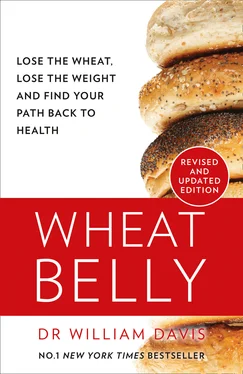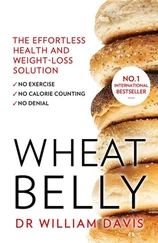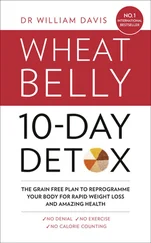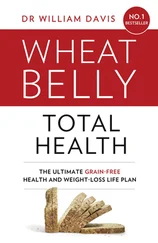Wheat and grain elimination is, by definition, part of low-carbohydrate diets. Clinical studies are accumulating that demonstrate the weight loss advantages of low-carb diets. 28, 29In fact, the success of low-carb diets originates largely from the elimination of wheat. Cut carbs and, by necessity, you cut wheat. Because wheat dominates the diets of most modern adults, removing wheat removes the biggest problem source. (I’ve also witnessed low-carb diets fail because the only remaining carbohydrate source in the diet was wheat-containing products.)
Sugar and other carbohydrates do indeed count, too. In other words, if you eliminate wheat but drink sugary sodas and eat candy bars and corn chips every day, you will negate most of the weight loss benefit of eliminating wheat. But most rational adults already know that avoiding Big Gulps and Cherry Garcia is a necessary part of weight loss. It’s the wheat that still seems counterintuitive.
Wheat elimination is a vastly underappreciated strategy for rapid and profound weight loss, particularly from visceral fat. I’ve witnessed the wheat belly weight loss effect thousands of times: Eliminate wheat and weight drops rapidly, effortlessly, often as much as 50, 60, 100, or more pounds over a year, depending on the degree of excess weight to start. Just among the last thirty patients who eliminated wheat in my clinic, the average weight loss was 26.7 pounds over 5.6 months.
The amazing thing about wheat elimination is that removing this food that triggers appetite and addictive behavior forges a brand-new relationship with food: You eat food because you need it to supply physiologic energy needs, not because you have some odd food ingredient pushing your appetite “buttons,” increasing appetite and the impulse to eat more and more. You will find yourself barely interested in lunch at noon, easily bypassing the bakery counter at the grocery store, turning down the donuts in the office breakroom without a blink. You will divorce yourself from the helpless, wheat-driven desire for more and more and more. And you will notice that your taste perception is enhanced. Foods like candy or cake that you formerly found tasty become sickeningly and intolerably sweet. Foods that you may not have been fond of before, such as Brussels sprouts or broccoli, yield new and delicious flavors that you couldn’t sense during wheat-consuming days, all part of the broad wave of gastrointestinal healing that occurs when your diet doesn’t include wheat and its cousins, a phenomenon that we will discuss in detail. (Apply this principle to kids, by the way, and watch them ask for veggies and chicken.)
It makes perfect sense: If you eliminate foods that trigger exaggerated blood sugar and insulin responses, you eliminate the cycle of hunger and momentary satiety. Eliminate the dietary source of addictive exorphins and you are thereby more satisfied with less. Excess weight dissolves and you revert back to physiologically appropriate weight. You lose the peculiar and unsightly ring around your abdomen: Kiss your wheat belly good-bye.
DOWN 104 POUNDS … 20 MORE TO GO
When I first met Geno, he had that familiar look: gray pallor, tired, almost inattentive. At 5 feet 10, his 322 pounds included a considerable wheat belly flowing over his belt. Geno came to me for an opinion regarding a coronary prevention program, triggered by concern over an abnormal heart scan “score,” an indicator of coronary atherosclerotic plaque and potential risk for heart attack.
No surprise, Geno’s girth was accompanied by multiple abnormal metabolic measures, including high blood sugars well into the range defined as diabetes, high triglycerides, low HDL cholesterol, high C-reactive protein and other measures of inflammation, and several others, all contributors to coronary plaque and heart disease risk.
I somehow got through to him, despite his seemingly indifferent demeanor. I believe it helped that I enlisted the assistance of his chief cook and grocery shopper, Geno’s wife. He was at first puzzled by the idea of eliminating all “healthy whole grains,” including his beloved pasta, and replacing them with all the foods that he had regarded as no-no’s such as nuts, oils, eggs, cheese, and fatty meats.
Six months later, Geno came back to my office. I don’t think it would be an exaggeration to say that he was transformed. Alert, attentive, and smiling, Geno told me that his life had changed. He had not only lost an incredible 64 pounds and 14 inches off his waist in those six months, but he had also regained the energy of his youth, again wanting to socialize with friends and travel with his wife, walking and biking outdoors, sleeping more deeply, along with a newly rediscovered optimism. And he had laboratory values that matched: Blood sugars were in the normal range, HDL cholesterol had doubled, triglycerides dropped from several hundred milligrams to a perfect range.
Another six months later, Geno lost 40 more pounds, now tipping the scale at 218—a total of 104 pounds lost in one year.
“My goal is 198 pounds, the weight I had when I got married,” Geno told me. “Only 20 more pounds to go.” And he said it with a smile.
BE GLUTEN-FREE BUT DON’T EAT “GLUTEN-FREE”
Say what?
Gluten is the main protein of wheat, and as I have explained, it is responsible for some, though not all, of the adverse effects of wheat consumption. The gliadin protein within gluten is the culprit underlying inflammatory damage to the intestinal tract in celiac disease. People with celiac disease must meticulously avoid foods containing gluten. This means the elimination of wheat, as well as other gluten-containing grains such as barley, rye, spelt, emmer, einkorn, triticale, bulgur, and kamut. People with celiac disease often seek out “gluten-free” foods that mimic wheat-containing products. An entire industry has developed to meet their gluten-free desires, from gluten-free bread to gluten-free cakes and desserts.
However, most gluten-free foods are made by replacing wheat flour with cornstarch, rice starch, potato starch, or tapioca starch (starch extracted from the root of the cassava plant). This is especially hazardous for health and for anybody looking to drop 20, 30, or more pounds, since gluten-free foods, though they do not trigger the immune or neurological response of wheat gluten, still extravagantly trigger the glucose-insulin response that causes weight gain. Wheat products increase blood sugar and insulin more than most other foods. But remember: Foods made with cornstarch, rice starch, potato starch, and tapioca starch are among the few foods that increase blood sugar even more than wheat products. Going gluten-free and indulging in gluten-free foods can therefore cause you to replace your wheat belly with a gluten-free belly accompanied by all the awful health consequences of excessive visceral fat—not good.
So gluten-free foods are not problem -free. Gluten-free foods are the likely explanation for overweight celiac sufferers who eliminate wheat and fail to lose weight. In my view, there is no role for gluten-free foods, since the metabolic effect of these foods is little different from eating a bowl of jelly beans even if it is cleverly disguised as seven-grain bread.
Thus, wheat elimination is not just about eliminating gluten. Eliminating wheat means eliminating the amylopectin A of wheat and other grains, the form of complex carbohydrate that increases blood sugar higher than table sugar and candy bars. But you don’t want to replace wheat’s amylopectin A with the rapidly absorbed carbohydrates of powdered rice starch, cornstarch, potato starch, and tapioca starch. Avoid gluten-free foods if you are gluten-free.
Later in the book, I will discuss the ins and outs of wheat removal, how to navigate everything from choosing healthy replacement foods to wheat withdrawal. I provide a view from the trenches, having witnessed thousands of people do it successfully.
Читать дальше












